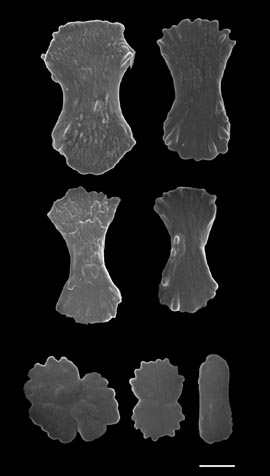CONTENTS
Introduction
The South Atlantic Bight
Methods
Octocoral Morphology
Glossary
Gorgonacean
Bauplan
see this for keys
Notes on the Species
Carijoa
riisei
Scleranthelia
rugosa
Telesto fruticulosa
Telesto nelleae
Telesto sanguinea
Bellonella rubistella
Pseudodrifa nigra
Nidalia occidentalis
Iciligorgia schrammi
Diodogorgia
nodulifera
Titanideum
frauenfeldii
Muricea pendula
Thesea nivea
Bebryce cinerea
Bebryce parastellata
Scleracis guadalupensis
Paramuricea sp.
Leptogorgia hebes
Leptogorgia punicea
Leptogorgia
cardinalis
Leptogorgia virgulata
Leptogorgia setacea
Leptogorgia euryale
Viminella
barbadensis
Renilla reniformis
Sclerobelemnon
theseus
Stylatula elegans
Virgularia presbytes
| Guide
to the Shallow Water (0-200 m) Octocorals of the South Atlantic
Bight.
S. T. DeVictor
& S. L. Morton, 2007
Sclerobelemnon theseus
Bayer, 1959 Remarks. This species has a club-like
shape with the stalk slightly longer than the rachis. The distal
end of the peduncle is slightly pointed and not inflated to any
extent. The examined specimen is about 7 mm at its widest point and
65 mm in length. The rachis contains some exert autozooids but most
are contracted, with minute, indistinct siphonozooids scattered
between calyces. The autozooids are arranged in 12 indistinct longitudinal
rows, leaving a bare dorsal streak along the back of the colony.
The axis is slightly flexible and the coenenchyme is tough and rubbery.
The color of the colony is creamy white in alcohol. Atlantic distribution: Charleston, 79 m, Gulf of
Mexico (unknown depth), Surinam, Trinidad, 57 m (Bayer, 1959b; Bayer,
1961; Williams, 1995; NMNH collections; SERTC collection). |
|
 |


